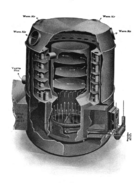Forced-air gas

Forced-air gas heating systems are used in central air heating/cooling systems for houses. Sometimes the system is referred to as "Forced hot air".
Design

Generally, they have a furnace heated by natural gas that pushes hot air through duct-work, then through vents to heat a building. Depending on the age of the system, forced air gas furnaces utilize either a pilot light or a solid state ignition system (spark or hot surface ignition) to light the natural gas burner.[2] The natural gas (a natural resource) is fed to buildings from a main gas line. The duct work supplying the hot air (and sometimes cool air if an AC unit is tied into the system) can be insulated or not. A climate-control device (e.g., thermostat) regulates and controls the usage of the furnace. A digital thermostat can be programmed to activate the gas furnace at certain times. For example, a resident may want the temperature in their dwelling to rise 15 minutes before returning from work.
Simple types of gas-fired furnace lose significant amounts of energy in the hot-temperature of the exhaust gases. Modern high-efficiency condensing furnaces condense the water vapour (one of the by-products of gas combustion) extracting the latent heat to pre-heat the incoming furnace airflow. This increases the efficiency (energy delivered into the building vs. heating value of gas purchased) to over 90%. An incidental beneficial effect is that the exhaust flue is much smaller and can be made of plastic pipe since the exhaust gas is much cooler. As a result it can be more easily routed through walls or floors. However, the condensing furnace is more expensive initially because of the extra induced draft fan and condensate pump required, and the extra heat exchanger in the firebox.
Areas of usage
Residential and commercial buildings located in rural and remote areas do not often use forced hot air systems. This is due to the financial impracticality of running natural gas lines many miles past areas of relative dense habitation. Usually these rural and remote buildings utilize oil heat, which is delivered by a truck. When reading ads for houses for sale in the MLS, this is abbreviated as FAG.
References
- ↑ Gromicko, Nick. "Gravity Furnace Inspection - InterNACHI". InterNACHI. Retrieved 2014-06-25.
- ↑ "How to Light a Furnace Pilot Light". Gas Furnace Guides. Retrieved 4 December 2012.